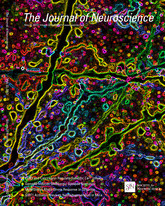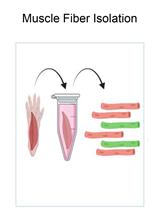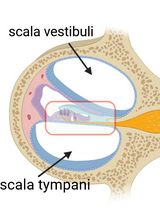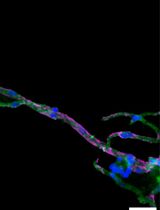- EN - English
- CN - 中文
Ex utero Electroporation into Mouse Embryonic Neocortex
小鼠胚胎新皮质的宫外DNA电转移
发布: 2013年12月20日第3卷第24期 DOI: 10.21769/BioProtoc.998 浏览次数: 11685
评审: Xuecai Ge
Abstract
This technique allows highly efficient and reproducible transfer of DNA/RNA into the embryonic neocortex of rodents across multiple ages. Ex utero electroporation compliments the more technically difficult in utero electroporation technique by maximizing the number of embryos for available for a given experiment, as well as increasing the variety of constructs used in each experiment, thereby helping to reduce their overall numbers. Ex utero electroporation followed by short term organotypic slice culture of embryonic brain sections allows immediate access to multiple slices for choosing optimal ones for live-cell imaging experiments, and characterization of various NSC manipulations in the intact stem cell niche. (see also “In utero Electroporation of Mouse Embryo Brains” (Ge, 2012); “Organotypic Slice Culture of Embryonic Brain Sections” (Calderon de Anda, 2013). Additionally, ex utero electroporated neocortices can be used for in vitro primary cell cultures with further dissection, dissociation into single cells, and plating on cover slips or in multi-well dishes according to standard techniques: note this procedure can be performed immediately after electroporation, prior to the onset of ectopic gene expression, or after overnight slice culturing to collect just the region of electroporated cells.
Materials and Reagents
- Timed embryonic mice embryos: A wide range of developmental timepoints work very well for this procedure, from E10-18.5. Note however that earlier embryos (E10-12.5) are very delicate and may require modified vibratome slicing techniques and/or manual cutting with a micro-knife, which can be embedded in collagen 3D-gels (to help preserve tissue structure) and cultured on Millicell inserts, or floated as whole brain explants overnight in a multi-well plate on a nutator/rotator. Likewise, older embryos E17-18 will have more developed skin and craniums, requiring a bit more force to inject DNA solution into the ventricles, which are becoming smaller relative to the size of the animal.
- DNA prepared at (≥1 μg/μl): Qiagen Maxi Prep kit (QIAGEN, catalog number: 12663 ) or EndoFree Plasmid Kit (QIAGEN, catalog number: 12362 )
- Fast green FCF (Sigma-Aldrich, catalog number: F7252 )
- HBSS (Life Technologies, catalog number: 14025-126 )
- 4% Low-melting point agarose (in sterile 1x PBS or 1x HBSS)
- Low-Melting point agarose (GeneMate Sieve GQA Agarose, catalog number: E-3112 )
- Ice
- Kimwipe
Equipment
- 35 mm dishes
- Multi-well cell culture dish (12 to 24 wells)
- Electroporator (BTX The Electroporation Experts, model: ECM 830 Square Wave Electroporation System)
- 3 mm-paddle Platinum Tweezertrodes (BTX The Electroporation Experts, model: 45-0487 )
- Footswitch for ECM 830 (BTX The Electroporation Experts, model: 1250FS )
- Mouth pipette (Sigma-Aldrich, catalog number: P0799-1PAK )
- Micropipettes (Borosilicate with filament O.D.: 1 mm, I.D.: 0.78 mm, 10 cm length) (SUTTER INSTRUMENT, catalog number: BF100-78-10 )
- Micropipette puller P-97/IVF (SUTTER INSTRUMENT)
- Dissecting stereoscope with flexible lighting
- Dumont forceps (#5 and #55) (Fine Science Tools)
- Disposable plastic transfer pipettes
- Sterile scalpel
- Fluorescent dissecting stereoscope for checking transfections
- Digital camera (if necessary) (OLYMPUS, model: MVX10 )
Procedure
文章信息
版权信息
© 2013 The Authors; exclusive licensee Bio-protocol LLC.
如何引用
Readers should cite both the Bio-protocol article and the original research article where this protocol was used:
- Nelson, B. R. (2013). Ex utero Electroporation into Mouse Embryonic Neocortex. Bio-protocol 3(24): e998. DOI: 10.21769/BioProtoc.998.
- Nelson, B. R., Hodge, R. D., Bedogni, F. and Hevner, R. F. (2013). Dynamic interactions between intermediate neurogenic progenitors and radial glia in embryonic mouse neocortex: potential role in Dll1-Notch signaling. J Neurosci 33(21): 9122-9139.
分类
神经科学 > 发育 > 形态建成
分子生物学 > DNA > 转化
细胞生物学 > 组织分析 > 组织分离
您对这篇实验方法有问题吗?
在此处发布您的问题,我们将邀请本文作者来回答。同时,我们会将您的问题发布到Bio-protocol Exchange,以便寻求社区成员的帮助。
提问指南
+ 问题描述
写下详细的问题描述,包括所有有助于他人回答您问题的信息(例如实验过程、条件和相关图像等)。
Share
Bluesky
X
Copy link












